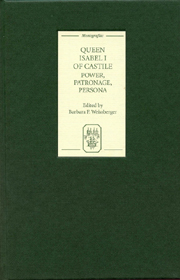Book contents
- Frontmatter
- Contents
- List of Contributors
- Acknowledgments
- Introduction: “Questioning the Queen, Now and Then”
- PART 1 INFLUENCE: ARAGON, PORTUGAL, AND NORTHERN EUROPE
- Part 2 Patronage: Reciprocal Relationships
- Part 3 Period: From Medieval to Modern
- “The Artistic Patronage of Isabel the Catholic: Medieval or Modern?”
- “Conflictive Subjectivity and the Politics of Truth and Justice in Cárcel de Amor”
- “Juan de Anchieta and the Rest of the World”
- “Inventing the Catholic Queen: Images of Isabel I in History and Fiction”
- Works Cited
- Index
“Inventing the Catholic Queen: Images of Isabel I in History and Fiction”
from Part 3 - Period: From Medieval to Modern
Published online by Cambridge University Press: 12 September 2012
- Frontmatter
- Contents
- List of Contributors
- Acknowledgments
- Introduction: “Questioning the Queen, Now and Then”
- PART 1 INFLUENCE: ARAGON, PORTUGAL, AND NORTHERN EUROPE
- Part 2 Patronage: Reciprocal Relationships
- Part 3 Period: From Medieval to Modern
- “The Artistic Patronage of Isabel the Catholic: Medieval or Modern?”
- “Conflictive Subjectivity and the Politics of Truth and Justice in Cárcel de Amor”
- “Juan de Anchieta and the Rest of the World”
- “Inventing the Catholic Queen: Images of Isabel I in History and Fiction”
- Works Cited
- Index
Summary
In the five hundred years since her death in November 1504, the renown of Isabel I of Castile seems to have never waned. On the contrary, she is more universally recognized by different cultures worldwide in the twenty-first century than she was in the fifteenth. As Isabel's fame grew over the years, her story expanded with it, acquiring the attributes of myth or legend. The most common image of Isabel as queen regnant is based on a series of events that occurred during her reign, which saw the unification of Castile and Aragon into one nation, the successful conclusion of the Christian reconquest of the Muslim kingdom of Granada, the backing of Columbus's exploration of the world beyond the Ocean Sea, and the establishment of the Inquisition. For some, Isabel's name also signifies the injustice and cruelties of the colonization and Christianization of the New World as well as those of the Inquisition, an institution whose reputation is burdened with its own truths and mythologies. Because she ruled at this moment, Isabel has been assigned responsibility, for better or worse, for all these events that subsequently and significantly affected the history of several cultures. The great importance assigned to the Queen has transformed her into a cultural icon, an individual who has transcended simple fame and has come to represent the Zeitgeist of fifteenth-century Spain with all its conflicts and contradictions.
- Type
- Chapter
- Information
- Queen Isabel I of CastilePower, Patronage, Persona, pp. 186 - 200Publisher: Boydell & BrewerPrint publication year: 2008

